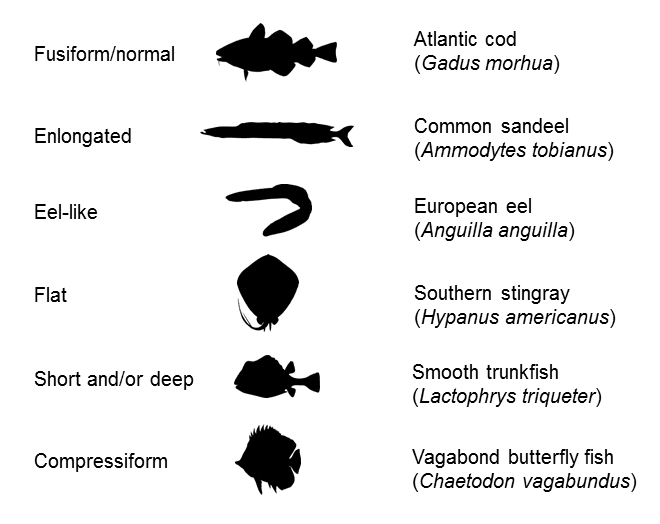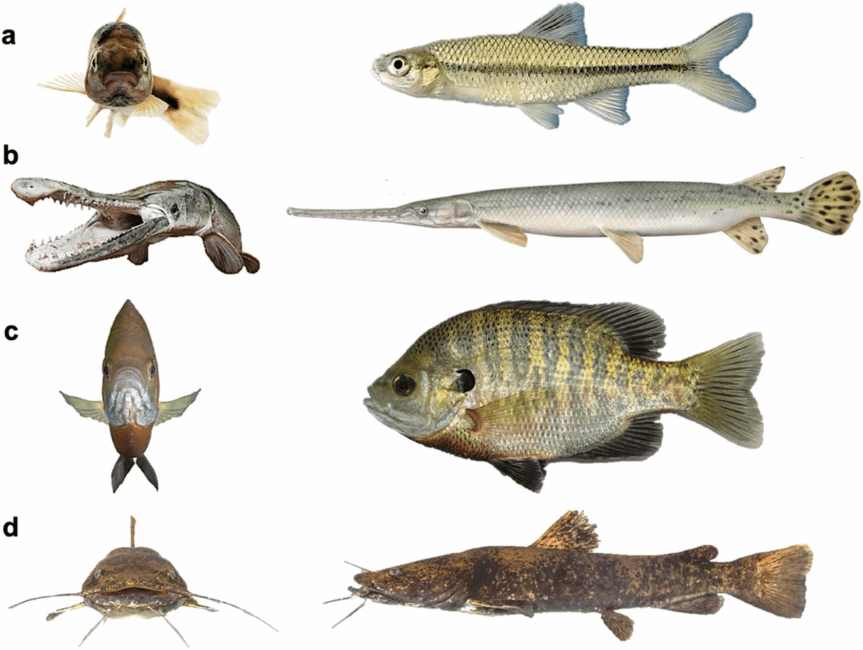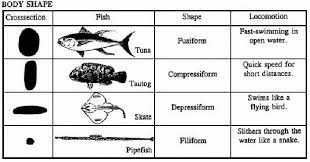The variety of fish body shapes refers to the different forms and structures that fish bodies can have. These shapes help fish survive in their specific environments.
The great ecological diversity of fish is reflected in the astonishing variety of fish body shapes and means of locomotion they possess. Indeed, much can be learned about the ecology of a fish simply by examining its anatomical features. Equally important is that these features also form the basics of most schemes of classification and identification.
Each shape is adapted to the fish’s lifestyle, making it better at finding food, escaping predators, or moving through its habitat.
Read Also: Fish Biology: Anatomy, Physiology, Embryology and Endocrinology
Basic Piscine Shapes (Fish Body Shapes)

Most fishes fall into one of six broad categories based on body configuration: fusiform ( rover-predator, piscivores (lie-in wait predator), surface-oriented fish, depressed (bottom fish), deep-bodied fish, and eel-like fish.
The way a fish looks is a good indicator of how it makes a living. Body shape, mouth location, and size, tail shape, and color can reveal a lot about a fish’s lifestyle.
1. Fusiform: Fusiform, or streamlined, fish like the barracuda or jack is capable of swimming very fast. They usually live in open water. This is the body shape that comes to mind when most people think of fish, streamlined (fusiform), with a pointed head ending in a terminal mouth and a narrow caudal peduncle tipped with a forked tail.
The fins are more or less evenly distributed about the body providing stability and maneuverability. Such fish typically are constantly on the move, searching out prey, which they capture through pursuit.
2. Laterally compressed: Fish that are laterally compressed are flattened from side to side or flatfish usually do not swim rapidly, although some schooling fish are an exception. However, they are exceptionally maneuverable. Many, like the angelfish, are found near coral reefs.
In these fish, the eye on the downward side migrates during development to the upward side, and the mouth often assumes a peculiar twist to enable bottom feeding. Flatfish have the most extreme morphologies of bottom fish.
3. Depressed: Depressed fish are flattened from top to bottom, like stingrays, live on the bottom. Bottom fish possess a wide variety of body shapes, all of them adapted for a life in nearly continuous contact with the bottom. In most such fish, the swim bladder is reduced or absent, and most are flattened in one direction or another.
Bottom fish can be divided into five overlapping types: bottom rovers, bottom clingers, bottom hiders, flatfish, and rattails. Bottom rovers have a rover-predator-like body except that the head tends to be flattened, the back humped, and the pectoral fin enlarged. Many sharks with their inferior mouths, flattened head, and large pectoral fins, can also be classified as bottom rovers.
Bottom clingers are usually small fish with flattened heads and large pectoral fins and structures (usually modified pelvic fins) that allow them to adhere to the bottom. Such arrangements are handy in swift streams or intertidal areas that have strong currents e.g. the gobies. Not only is the mouth completely ventral in these fish, but their main water intake for respiration (the spiracles) is located on top of the head.
4. Eel-like (Elongated): They have elongated bodies, blunt or wedged shape, and tapering or rounded tails. They are characterized by their long and thin, like an eel, for slipping through tight spaces. If paired are present they are small, while the dorsal and anal fins are typically quiet long. Scales are small or embedded and even absent.
In cross-section, their bodies can range from compressed to round. Eel-like fish are particularly well adapted for entering small crevices and holes in reefs and rocky areas, for making their ways through beds of aquatic plants, and for burrowing into soft bottoms.
5. Globiform: They are characterized by their round and bulky, like a pufferfish, often for protection and maneuverability.
Other piscine features

Many fish like the boxfish and porcupine fish do not fit into any of these categories. They are slow swimmers with special protective mechanisms.
1. Tails
The shape of the tail can be an indicator of how fast a fish usually swims.
a. Crescent-shaped: Fish with crescent-shaped tails, like swordfish, are fast swimmers and constantly on the move.
b. Forked: Fish with forked tails, like the striped bass, are also fast swimmers, though they may not swim fast all of the time. The deeper the fork, the faster the fish can swim.
c. Rounded: Fish with a rounded or flattened tail are generally slow-moving, but are capable of short, accurate bursts of speed.
Read Also: Introduction to Fishing Gear Technology
2. Mouths
The location and size of the mouth can be a good indicator of the food a fish eat and where it lives. Fish with large mouths generally eat large food items like other fish; however, the whale shark eats very small organisms which it strains from the water with its huge mouth.
Fish with small mouths eat small food items: small crustaceans or mollusks; and, fish with tiny mouths eat tiny things like zooplankton.
1. Terminal: A terminal mouth is located on the end of the head. Fish with terminal mouths may chase and capture things, like the tuna, or pick at things, like the butterfly fish.
2. Up-Pointing: A fish with an up-pointing mouth has a long lower jaw. The mouth opening is toward the top of the head. The tarpon has this kind of mouth. It feeds near the surface.
3. Sub-Terminal: A sub-terminal mouth is on the underside of the head. Fish with this type of mouth usually feed on the bottom. The bonefish has a sub-terminal mouth. Some fish have specialized mouths. The seahorse has a tiny mouth at the end of a straw-like snout that is used to slurp zooplankton.
3. Colour
a. Red: Red is a common color in fish. You might think that redfish would be very easy for a predator to find. However, most fish that have this coloration live in dark or deep water or are nocturnal (active at night).
In deep water red light is filtered out quickly so red is a good camouflage. At night red-colored objects appear gray. The squirrelfish has this kind of coloration.
b. Counter-shading: Many fish are dark on top and light on the bottom. Most of these fish are found in open-ocean. When seen from above they disappear by blending in with the dark color of the depths or the bottom. From below the light belly blends into the sky above. The tuna is counter-shaded. Seabirds like puffins are also counter-shaded.
c. Disruptive Coloration: This is a form of camouflage. The patterns and lines break up the outline of the fish or help it to blend into the background. The brightly patterned fish of coral reefs blend in with the corals despite their brilliant colors. The Moorish idol exhibits disruptive coloration.
d. Eye Spots: Eye spots are a form of mimicry. The eye spot, usually found near the tail, draws attention away from the real eye which is a target that a predator might strike. The eye spot may cause the predator to attack the wrong end and allow the fish to escape alive.
e. Camouflage: Many fish have colors or patterns that match their backgrounds. The flounder is a camouflaged fish. It can even change color to match different backgrounds.

In summary, although life in water puts many severe constraints on the design o fish, the presence of thousands of species living in wide varieties of habitats means that these constraints are pushed to their limits. This results in many very unlikely forms, such as seahorses and lumpfishes. Understanding the significance of the peculiar external anatomy of such forms practically requires a study on a case-by-case basis.
On the other hand, species that are more recognizably as fishlike can usually be placed in some sort of functional category though the examinations of body shape, scales, fins, mouth, gill openings, sense organs and miscellaneous structures. The great ecological diversity of fish is reflected in the astonishing variety of body shapes and means of locomotion they possess. Fish display a great variety of forms and are adapted to the environment in which they live in many ways.
The great ecological diversity of fish is reflected in the astonishing variety of body shapes and means of locomotion they possess. Fish display a great variety of forms and are adapted to the environment in which they live in many ways. Most fishes fall into one of six broad categories based on body configuration: fusiform (rover- predator, piscivores (lie-in wait predator), surface-oriented fish, depressed (bottom fish), deep-bodied fish, an eel-like fish, which also reflects their modes of life.
Read Also: Impact of Agricultural Wastes on Human and Environment
